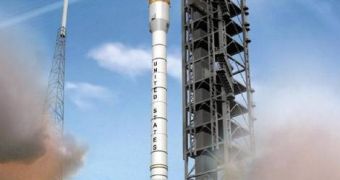The American space agency's new delivery system, the ARES I, seems to be faced with a lot of problems. The most recent is one that doesn't come to many people's minds when thinking about going to orbit, and that's bubbles. Indeed, it would appear that engineers at NASA are currently working out new ways of ensuring that bubbles are not formed within the craft's liquid fuel tanks. According to one of the experts working on the design, even the smallest such bubbles in the tanks could have disastrous consequences for the ship, as well as its cargo and occupants.
“You get cavitation – a tiny but powerful pressure wave – that can erode bits of metal from the rocket's fuel pump. If those metal bits make it into the rocket engine, it is not good. If you pressurize the fuel, it helps force it into the rocket engine, and you can avoid bubbles and cavitation because the fuel pump doesn’t have to work so hard,” Goddard Space Flight Center cryogenics branch expert Robert Boyle, who is the head of a technical team working on a new liquid helium pump for ARES I, explained.
He also added that the piston pump, which would fill the delivery system, would be located on the rocket's servicing tower at its Kennedy Space Center launch site, and not on the craft itself, ScienceDaily reports.
Behind the propelling force of ARES I lies an intricate, helium-based pumping system, which operates at about 4.5 degrees Kelvin (about minus 452 degrees Fahrenheit, or minus 268 degrees Celsius). The gas, which, at this temperature, is a fluid about 300 times less viscous than water, flows under pressure from ten 30-inch spheres inside the tank, where it causes a large expansion on account of the heat there.
Afterwards, it's pushed back to the tanks, but this time to those where liquid hydrogen and liquid oxygen can be found. Because of its pressure, helium forces the other two compounds to the engines as well.
But engineering a system that allows for such complex operations with helium has not been an easy task, mostly because regular valves and cylinder walls cannot keep the almost-gas-like fluid in place. Therefore, the places inside the pistons where helium can enter the “power plants” are actually cracks in the wall, less than one tenth of a human hair in diameter. “You lose about 5 percent of the helium through the gap – so sue me. It's a lot cheaper than having to tear apart the pump and repair it over and over,” Boyle said.
“I've worked on cryogenic projects for many science missions, like COBE, Terra, and Aqua, so it's nice to have a chance to work on a human spaceflight project. It's certainly easier to relate to my kids – they get excited when I talk about it. Traveling to Kennedy Space Center is great, also – after our November 14 meeting last year, we saw the night launch of the shuttle – it was spectacular,” he concluded.

 14 DAY TRIAL //
14 DAY TRIAL //